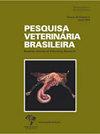在巴西巴伊亚州南部,可可农场中的狗(Canis lupus familiaris)作为寄生虫携带者的重要性可能会传播给人类和野生动物
IF 0.8
4区 农林科学
Q3 VETERINARY SCIENCES
引用次数: 2
摘要
摘要:家犬(Canis lupus familiaris)被认为是一种入侵物种,因为它们已被人类引入世界各地,对野生动物保护构成了威胁。农林业系统的大规模扩展,可可豆在当地树木的树荫下种植,有助于巴西巴伊亚州南部的野生动物保护。然而,这一系统可以增加本地动物物种和家狗之间的接触,这些狗经常被农村工人带到田地里。本研究的目的是调查可可农林复合系统中家养狗的存在以及两个保护区附近可可农场狗的蠕虫发生情况:乌纳生物保护区(REBIO-Una)和巴伊亚乌纳的Serra das Lontras国家公园。调查犬类的年龄、性别、品种、喂养频率、疫苗接种、驱虫等一般特征,评估犬类寄生虫对野生动物和人类的污染风险。在8个可可农林复合系统和3个相邻的森林碎片上设置了相机陷阱。为了进行寄生虫学调查,收集了生活在八个可可农场的家狗的粪便样本。共登记了12种哺乳动物的539张照片,其中15%为家犬。这项寄生虫学研究是用生活在可可农场的39只狗中的32只狗的粪便样本进行的。其中,线虫属包括钩虫属(80.7%)、圆线虫属(38.4%)、弓形虫属(30.7%)、螺旋体(15.4%)和滴虫属(11.5%)。在动物护理方面,所有狗的身体状况都很差,49%的狗每天喂食两次,90%的狗在森林或可可农林系统中排便,只有33%的狗定期驱虫,64%的狗在不到12个月内接种了狂犬病疫苗,只有一只狗接种了其他病毒疫苗。结果表明,家犬与野生动物生活在相同的环境中,但缺乏一些基本的卫生保健,这增加了环境污染导致家犬、野生动物和人类之间寄生虫传播的可能性。我们强调有必要负责任地饲养宠物,并监测生活在该地区的野生动物和人口的健康。本文章由计算机程序翻译,如有差异,请以英文原文为准。
The importance of the dog (Canis lupus familiaris) in cocoa farms as carriers of helminths potentially transmissible to humans and wildlife in the Southern Bahia, Brazil
ABSTRACT: Domestic dogs (Canis lupus familiaris) can be considered an invasive species as they have been introduced by humans in different parts of the world and represent a risk to wildlife conservation. Large extensions of agroforestry systems, where cocoa is grown under the shade of native trees, contribute to wildlife conservation in southern Bahia, Brazil. However, this system can increase contact between species of the native fauna and domestic dogs, which are frequently taken to the fields by rural workers. The aims of this study were to investigate the presence of domestic dogs inside cocoa agroforestry systems and the occurrence of helminths in dogs from cocoa farms near two protected areas: the Una Biological Reserve (REBIO-Una) and the Serra das Lontras National Park in Una, Bahia. We also investigated general characteristics of the dogs such as age, sex, breed, feeding frequency, vaccination, deworming and others, and evaluated possible risks of wildlife and human contamination by the domestic dog parasites. Camera traps were set up on eight cocoa agroforestry systems and three adjacent forest fragments. For parasitological investigation, fecal samples were collected from domestic dogs that lived on the eight cocoa farms. A total of 539 photos of 12 mammals were registered, of which 15% were of domestic dogs. The parasitological research was carried out with fecal samples from 32 of the 39 dogs that lived in the cocoa farms. We found one genus of cestode, Dipylidium sp. (7.7%), and five genera of nematodes, Ancylostoma sp. (80.7%), Strongyloides sp. (38.4%), Toxocara sp. (30.7%), Spirocerca sp. (15.4%) and Trichuris sp. (11.5%). Regarding animal care, all dogs were in poor body condition, 49% were fed twice a day, 90% defecated in the forest or cocoa agroforestry systems, only 33% were periodically dewormed, 64% were vaccinated against rabies in less than 12 months, and only one dog was vaccinated against other viruses. The results showed that domestic dogs share the same environment as wild animals yet lack some basic health care, increasing the possibility of parasitic transmission between domestic dogs, wildlife and humans from environmental contamination. We highlight the need for responsible pet ownership and the monitoring the health of wild animals and the human population living in this region.
求助全文
通过发布文献求助,成功后即可免费获取论文全文。
去求助
来源期刊

Pesquisa Veterinaria Brasileira
农林科学-兽医学
CiteScore
1.30
自引率
16.70%
发文量
41
审稿时长
9-18 weeks
期刊介绍:
Pesquisa Veterinária Brasileira - Brazilian Journal of Veterinary Research (http://www.pvb.com.br), edited by the Brazilian College of Animal Pathology in partnership with the Brazilian Agricultural Research Organization (Embrapa) and in collaboration with other veterinary scientific associations, publishes original papers on animal diseases and related subjects. Critical review articles should be written in support of original investigation. The editors assume that papers submitted are not being considered for publication in other journals and do not contain material which has already been published. Submitted papers are peer reviewed.
The abbreviated title of Pesquisa Veterinária Brasileira is Pesqui. Vet. Bras.
 求助内容:
求助内容: 应助结果提醒方式:
应助结果提醒方式:


